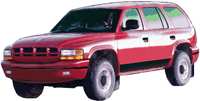Owners of sport utility vehicles, pickup trucks and vans may get hit with higher insurance rates because of the damage they cause in crashes with smaller vehicles while people who own smaller cars may get a break on their insurance because they cause less damage to other vehicles.
What!? Go back and read that again.
 Some
insurance companies, led by Farmers Insurance Group and Progressive
Corp. are suggesting a new way of doing business. What they are
suggesting is basing liability insurance on the make and model of the
vehicle instead of basing it on the driver -- using age, sex, driving
record and other factors to determine how likely the person will be
involved in an accident. Never mind that the driver of the larger
vehicle is probably safer in that large vehicle.
Some
insurance companies, led by Farmers Insurance Group and Progressive
Corp. are suggesting a new way of doing business. What they are
suggesting is basing liability insurance on the make and model of the
vehicle instead of basing it on the driver -- using age, sex, driving
record and other factors to determine how likely the person will be
involved in an accident. Never mind that the driver of the larger
vehicle is probably safer in that large vehicle.
Folks, these insurance companies just are not satisfied with how much of your money they are getting. Eyeing the fact that larger vehicles account for more than half of new vehicle sales in the United States, and that their popularity is continuing to rise, these folks are beginning to gleefully count more of your money - as theirs.
They must figure that since the larger vehicles cost more, those who can afford them should also pay higher insurance premiums. Besides, who drives those sport utility vehicles and vans anyway? Hey, it's 'soccer moms' and sportsmen. Surely if those families can afford all those sporting activities for their kids they have more disposable income to redistribute to the less fortunate person driving subcompact cars, such as the Ford Festiva and Dodge Colt.
Or maybe these bleeding-heart liberals see getting people out of SUV's as somehow bringing "fairness" in auto accidents. Since the driver of the SUV is less likely to suffer injury in a crash, and the driver of the smaller car is more likely to suffer injury, their idea of fairness is to remove the safety advantage of the SUV owner.
In a limited experiment in the Pennsylvania market sport-utility owners are charged a 5-percent premium for having the larger vehicles, while certain passenger car owners receive a 10-percent discount.
What can you do about it? Well, probably nothing besides giving them more of your money. There's no option to 'opt-out' because they have already managed to pass into law a requirement for you to carry liability insurance. State laws require us to buy coverage for vaguely defined noneconomic damages. And that's where big lawsuits, hefty attorney fees and higher auto insurance premiums come in. Want to venture a guess who spearheaded those laws? (hint: insurance companies and attorneys) What a novel idea - require people by law to buy your product (insurance) and then raise the price of it over and over and over again. Is it any wonder these insurance peddlers are so wealthy? Hey! It's Your Money!